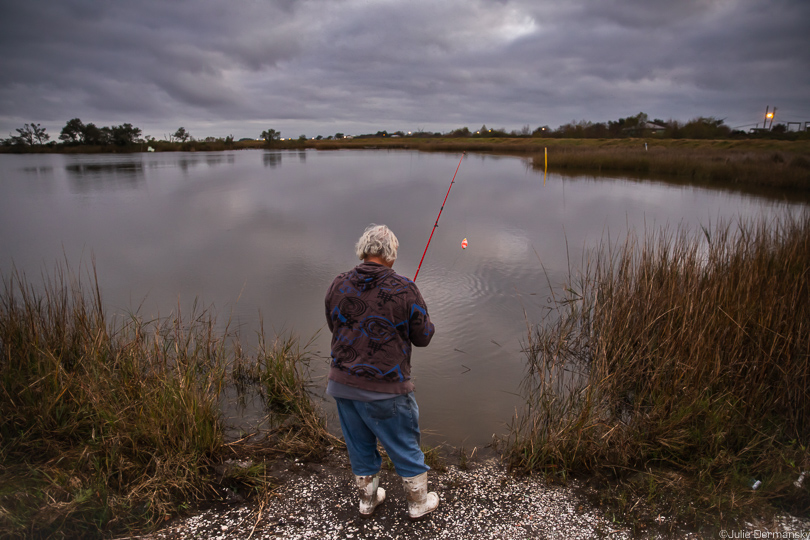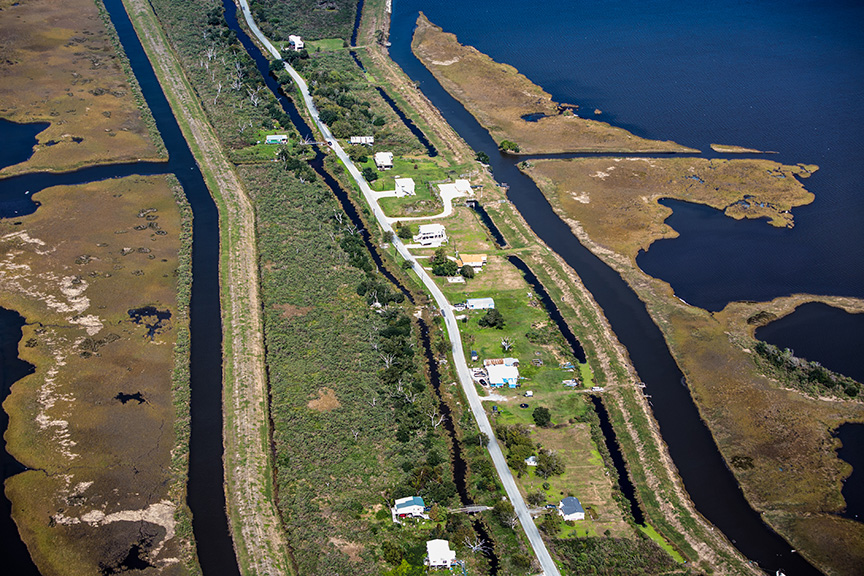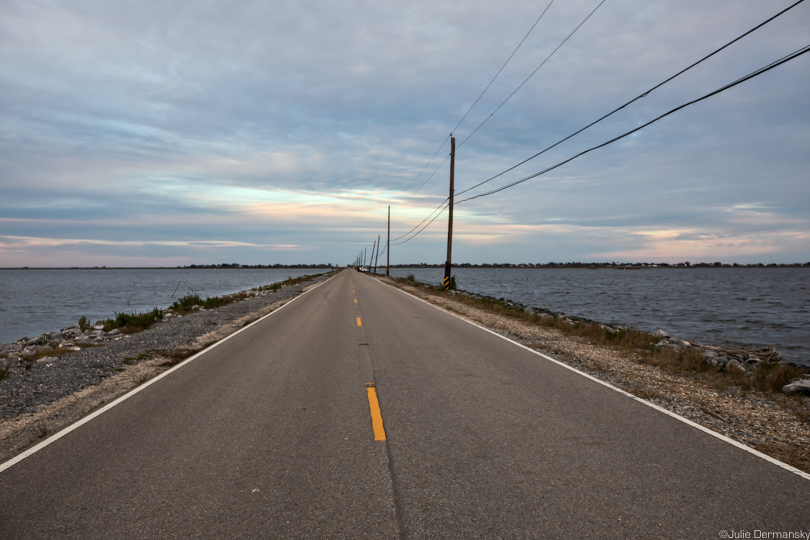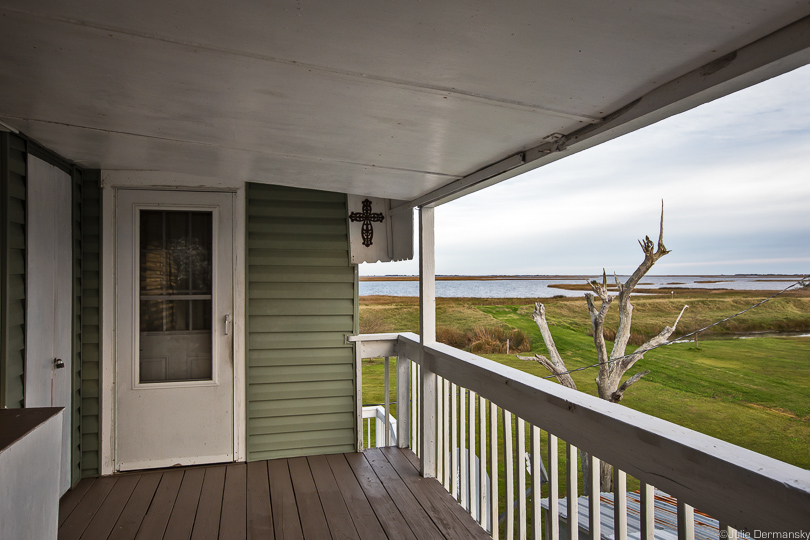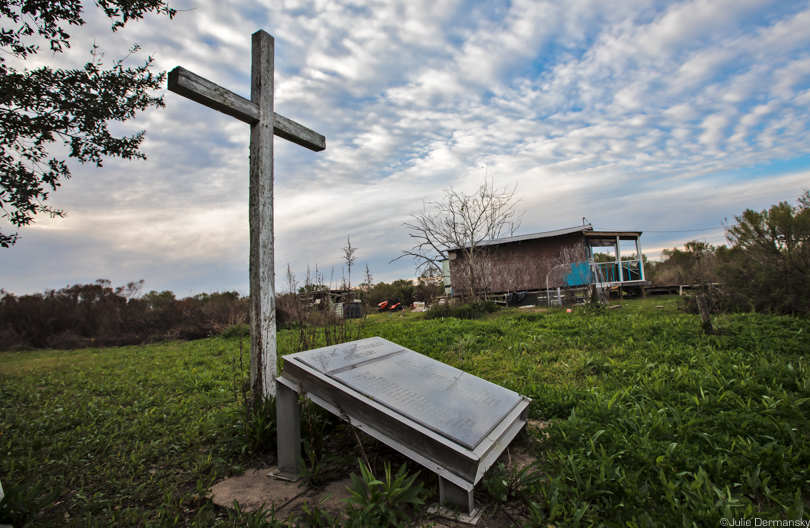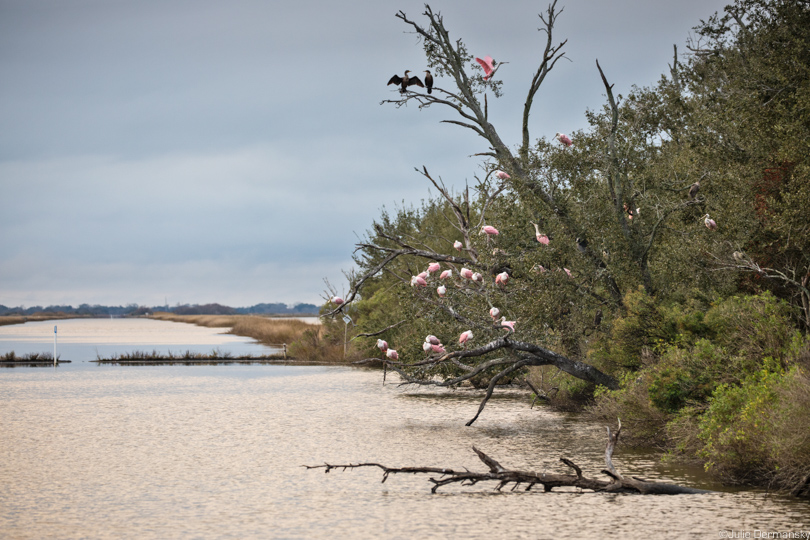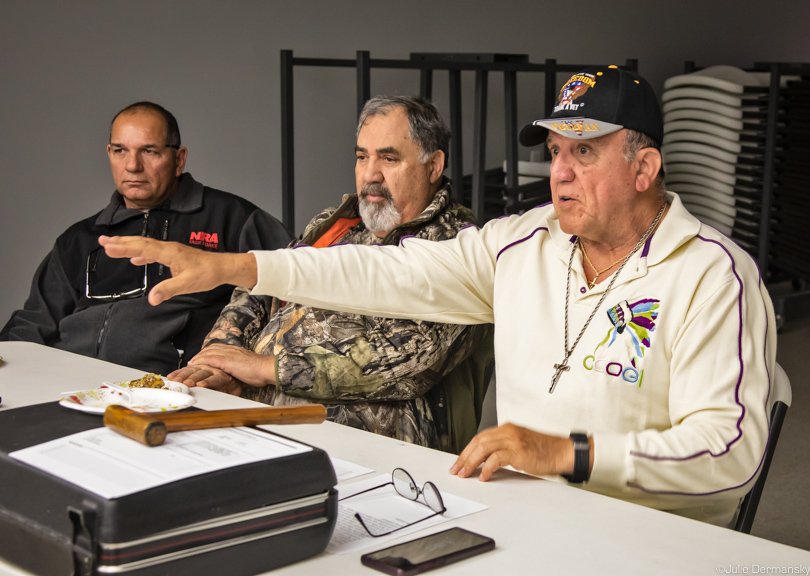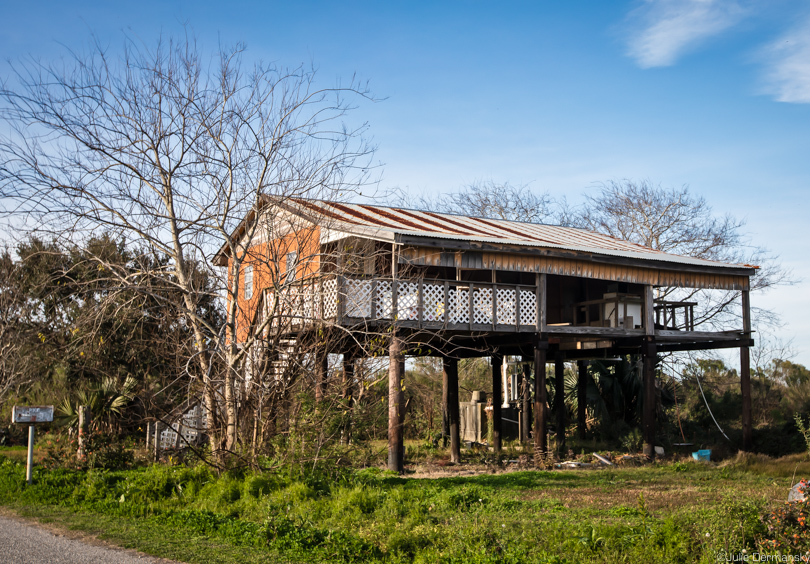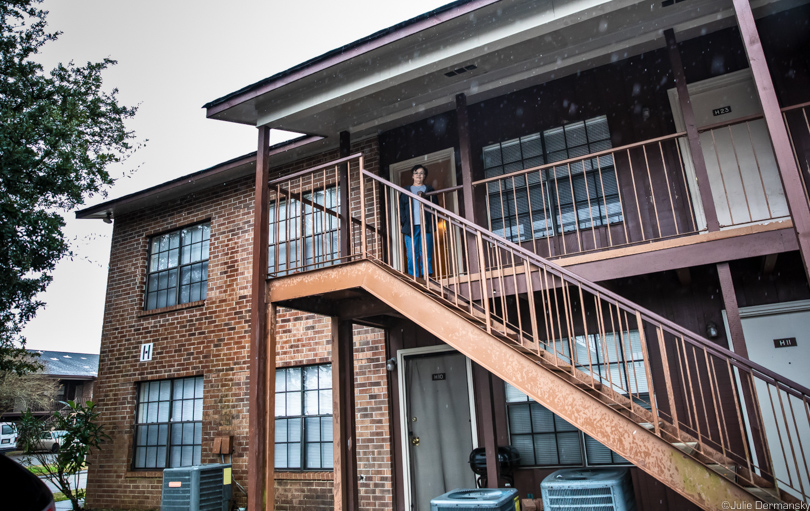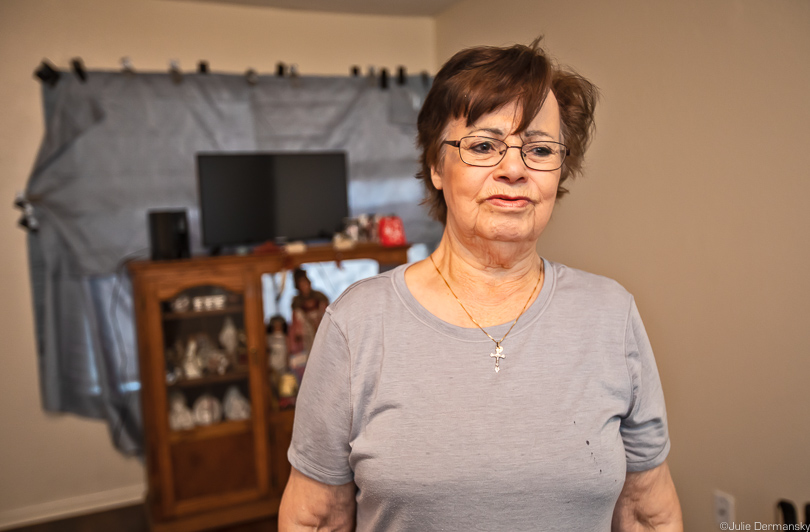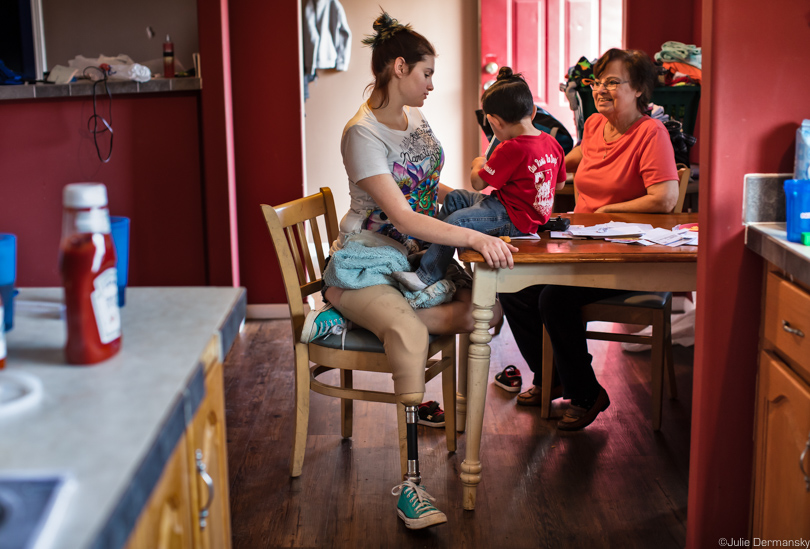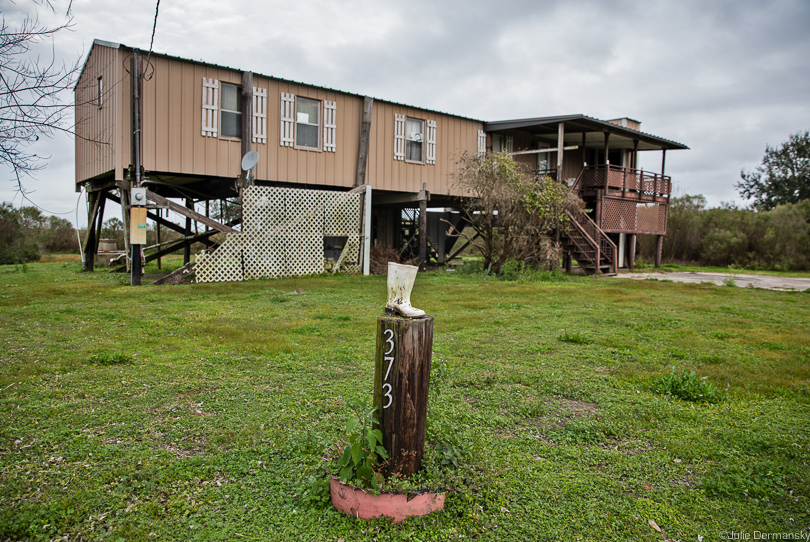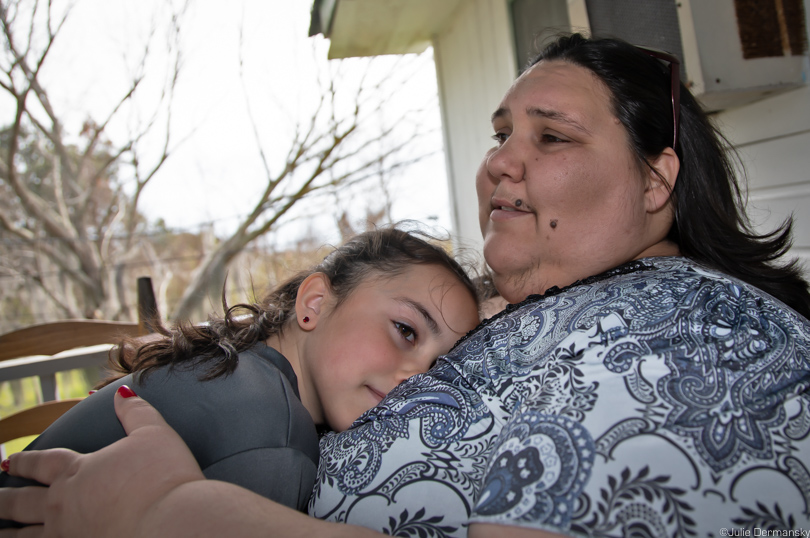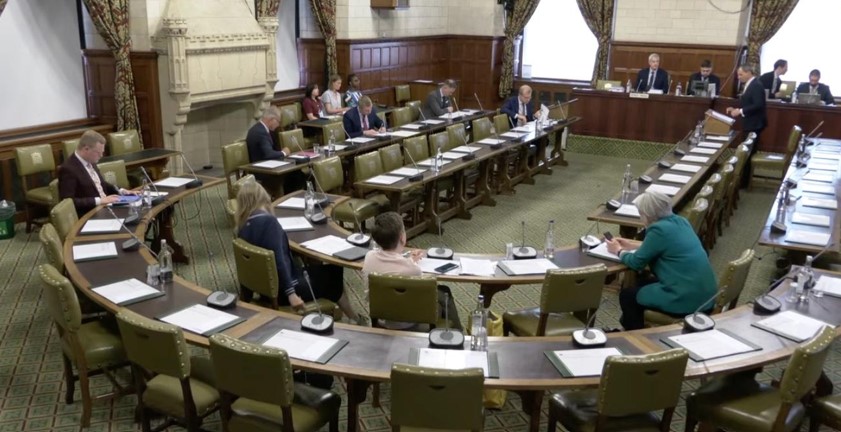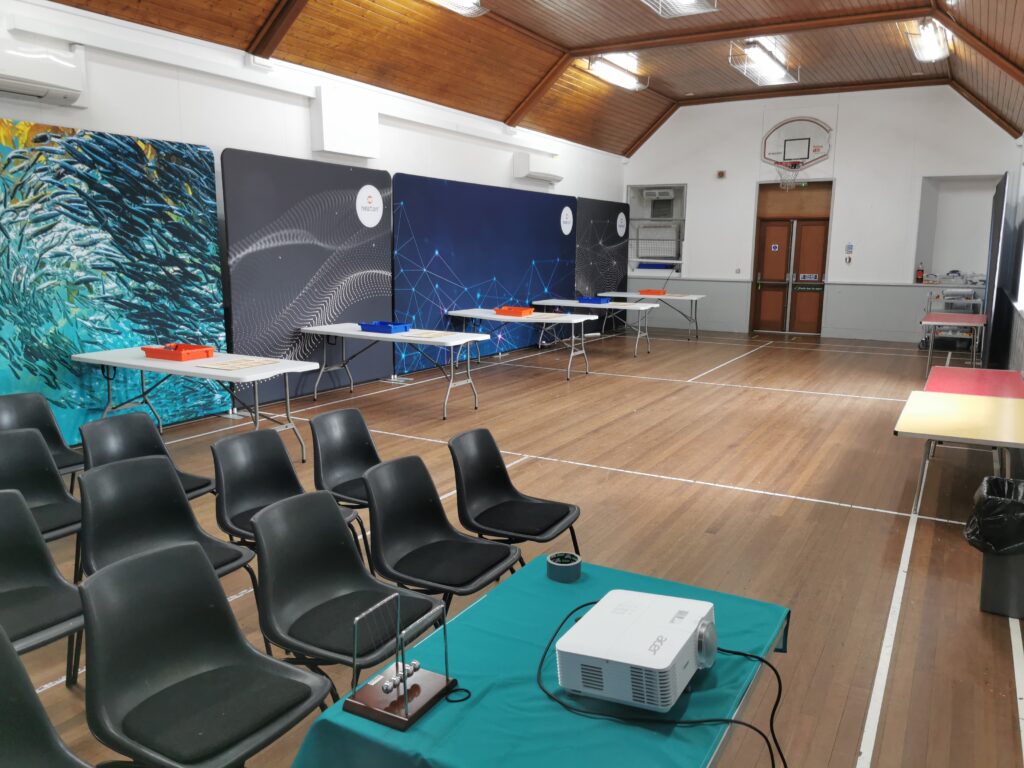After DeSmog broke the news that the Isle de Jean Charles Biloxi-Chitimacha-Choctaw Tribe (IDJC) was considering ending its partnership in a $48 million climate change resettlement project, talks have restarted between the Louisiana Office of Community Development (OCD) and the Tribe in an attempt to fix the rift.
On January 24, Pat Forbes, executive director of the OCD, met with IDJC Chief Albert Naquin and local officials. “The door is back open to find common ground,” Chief Naquin told me after the meeting.
At stake is the success of the first federally funded resettlement project meant as a template for coastal communities facing rising sea levels from climate change.
Isle de Jean Charles, home of the IDJC Tribe, is a narrow island in the wetlands of south Terrebonne Parish, Louisiana, about 80 miles southwest of New Orleans. Since 1955, the island has lost 98 percent of its land due to a combination of levee construction, coastal erosion, sinking land, rising seas, and damage from hurricanes, worsened by climate change. Only a 320-acre strip remains today, and the population has fallen from 400 to a few dozen families.
Aerial view of Louisiana’s shrinking Isle de Jean Charles. Flight made possible by Southwings.
A Vision for the Future of the IDJC Tribe
Over a decade ago the IDJC Tribal Council began creating a resettlement plan that aimed to move the Tribe inland and reunite displaced members who had moved away over the years. Working with the Lowlander Center, a nonprofit with a long-standing relationship with the Tribe and connected to scientists, researchers, and planners dealing with coastal issues, the Tribe developed this plan as a road map for other coastal communities inevitably facing relocation due to climate change.
The plan covers issues such as energy independence, clean water infrastructure, and hazard mitigation through building and land design. In addition, this plan was meant to foster “a strong expression of cultural integrity and tribal sovereignty. The plan as created was a holistic concept design for maximum health and well-being of the immediate and surrounding communities,” according to Dr. Kristina Peterson of the Lowlander Center.
The Tribe’s plan is built around the concept of the “community of practice,” a term coined by anthropologists Jean Lave and Étienne Wenger. “Communities of practice are groups of people who … develop a shared repertoire of resources: experiences, stories, tools, and ways of addressing recurring problems — in short, a shared practice. This takes time and sustained interaction,” according to Lave and Wenger.
In 2015 the IDJC Tribe partnered with Louisiana’s Office of Community Development (OCD), which incorporated the Tribe’s resettlement proposal into a grant application to the U.S. Department of Housing and Urban Development’s National Disaster Resilience Competition. And in 2016 the OCD won $92 million in funds, with $48 million earmarked for the Tribe’s resettlement plan.
But discord between the Tribe and the State started shortly after the award was announced when the State started retooling the original proposal.
Island Road, the only road to Isle de Jean Charles in Terrebonne Parish, Louisiana.
View from a raised home on Isle de Jean Charles.
The OCD’s Forbes explained over the phone that after he learned IDJC Tribe members were not the only island inhabitants, as their proposal suggested, he had to change the State’s focus to the individual island residents instead of the tribal community to avoid discrimination.
Chief Naquin points out that his Tribe is the only one associated with the island. Its members are descendants of the Biloxi, Chitimacha, and Choctaw Indians, who eventually escaped to the island after forced relocations under the Indian Removal Act of the 1830s. He also notes that the IDJC Tribe was recognized by Louisiana in 2004 and currently is seeking federal recognition.
According to Chief Naquin, besides one person not affiliated with any tribe who took up residency on the island in 2010, all remaining Isle de Jean Charles residents are part of the IDJC Tribe as of 2019. This disputes the United Houma Nation’s 2016 claim that some of its tribal members live on the island and prompted the OCD to rework the IDJC Tribe’s resettlement proposal.
The 2018 National Climate Assessment dedicated an entire chapter to the IDJC Tribe, with no mention of other tribes having a stake in the resettlement plan. However, it does note that “the relocation funds now are for all residents of Isle de Jean Charles, according to the Louisiana State Office of Community Development.”
Cemetery on the Isle de Jean Charles.
Spoonbills roosting on a tree on the Isle de Jean Charles.
Diverging Visions
The only thing the State of Louisiana and the Tribe now agree on is the urgency of relocating the few dozen families (which the OCD concedes are mostly IDJC Tribe members) who remain on the island. Some tribal council members told me they worry that the State has diverged from the Tribe’s original vision so radically that instead of its model sustainable and disaster-resilient community, the new development will be a resettlement subdivision — which are exactly the words a parish official used to describe the project during a January 4 meeting of state, parish, and tribal officials.
Fossil fuel industry site off Island Road.
Left to right: Isle de Jean Charles Biloxi-Chitimacha-Choctaw Tribal Councilman Tommy Dardar, Deputy Chief Wensceslaus Billiot Jr., and Chief Albert Naquin at a Tribal Council Meeting on January 26.
Chief Naquin held a tribal council meeting on January 26 to discuss the conditions required of the State for the Tribe to feel comfortable remaining a partner in the resettlement project.
Some at the meeting expressed doubt the partnership is in the Tribe’s best interest and said they are losing precious time trying to salvage it. The Tribe’s resettlement vision is about more than relocating its remaining members off of the disappearing island. It is also intended to reunite some of the 600 tribal members who began leaving the hurricane-battered island decades ago. This vision would enable the dispersed Tribe to grow and help preserve its culture.
They fear that any state-run community, no matter how attractive the vision, will turn out to be like Section 8 housing (a federal low-income housing assistance program). That fear stems, in part, from talk that some of the families who took advantage of temporary housing assistance offered by the ODC gave up their homes on the island and ended up in housing developments where they don’t feel safe.
Rita Falgout’s home on the Isle de Jean Charles.
Rita Falgout, in front of the apartment in Houma that she moved to courtesy of the OCD’s Optional Relocation Assistance Program from her home on Isle de Jean Charles, while waiting for the resettlement project’s community to be built.
Tribal Council’s Diminished Role Leaves Tribal Members Vulnerable
The OCD offered those living on the island or who moved off after being displaced by Hurricane Isaac in August 2012 assistance toward securing “safe interim housing while the permanent resettlement housing solutions are designed and constructed.” Those who qualified could take part in its Optional Relocation Assistance Program.
The IDJC Tribal Council had nothing to do with screening the selected housing options in the State’s relocation assistance program, nor was it given an opportunity to make sure its members understood what they were committing to beforehand.
Chief Naquin said he warned the State that if the council wasn’t involved, he feared some tribal members could end up isolated and in bad situations, but that his concerns were brushed off.
While some tribal members who opted to move off the island are happy with their temporary housing, at least one member of the IDJC Tribe is not. Rita Falgout is an 83-year-old grandmother living in an apartment complex in Houma, a city about 25 miles north of the island that her family describes as “the hood.”
Falgout is glad she got off the increasingly flood-prone island. But she says she doesn’t feel safe in her apartment, and wouldn’t have signed a lease if she had realized how unsafe she would feel living there.
After joining the state’s transitional housing program, Falgout didn’t feel safe in the first house she moved to in Houma and then moved to an apartment, which is where I visited her.
Right after moving in, Falgout found men looking in the window and was troubled by someone pointing a laser light inside. She recounted two recent occasions when strangers started what she considered inappropriate conversations with her in the common laundry room. A man in his twenties said he wanted to date her and a woman also in her twenties who claimed to be a victim of sex trafficking said she wanted someone to hang out and talk with.
Falgout turned them both down. She didn’t trust their intentions and was concerned both seemed to know which unit she lives in. She no longer plans to use the laundry facilities at the apartment complex.
Her daughter helped her cover her windows with sheets so no one could look in. She misses the view from her island home and being able to go outside without worrying who might be behind her.
Falgout in the living room of her apartment in Houma, where her windows are covered with sheets and have furniture in front of them.
The housing complex does not have a higher crime rate than other locations in Houma, according Lt. Peter Guidry with the Terrebonne Parish Sheriff’s Office.
However, Bobbie O’Bryan, a Houma police officer who works with the homeless, told me that Falgout likely would have felt safer in some of Houma’s housing complexes for the elderly, which likely meet the same guidelines required by OCD’s housing program. (O’Bryan was speaking as a private citizen not on behalf of the police department.)
Falgout’s granddaughter Amber told me her grandmother was only offered a few choices and that Amber didn’t think any of them were appropriate. Amber plans to have Falgout move in with her in Pointe-aux-Chenes, closer to the island, when the lease ends in a few months.
Rita Falgout with her great-grandson and her granddaughter Amber in Pointe-aux-Chenes, where the grandmother plans to move when her lease is up.
Falgout would move out tomorrow but is convinced she would have to pay the rent the state is paying on her behalf if she leaves before her lease is up.
Her belief may be unfounded. When questioned about Falgout’s situation, Marvin McGraw, OCD’s communications director, said he couldn’t discuss individual cases. He sent me a link to the agreement those who participate in the program had to sign, and he assured me participants in the program can get copies of anything they signed.
However, in Falgout’s case, because she doesn’t remember signing the OCD agreement, she hasn’t asked for a copy and thinks she is stuck in her current apartment despite not feeling safe.
Having an elderly tribal member end up in a housing complex where she is an easy target was a situation bound to happen when the State took the lead on the resettlement project, IDJC Councilman Tommy Dardar told me. If the tribal council were more involved in the process, he has no doubt that Falgout would not be in that position.
Up to half of the remaining tribal members on the island are illiterate, according to Dardar and about a third can’t even sign their names.
“Falgout is in more danger over there than on the island. At least with the water you can see it coming up, but when you get mugged, you just don’t know,” Dardar said.
State Defends Housing and Resettlement Efforts
McGraw explained that those who took advantage of the Optional Relocation Assistance Program were able to work with a housing specialist to help select a temporary home while the new community is being developed and stressed that no one was forced to participate in the program. He implied Falgout is responsible for her current unsatisfactory situation.
McGraw went as far as to suggest that by reporting on Falgout’s situation, I am exploiting her in some way. I explained that Falgout’s situation has led some tribal council members to believe that any housing the state creates will end up feeling similarly unsafe. McGraw scoffed at the idea.
He assured me the proposed housing would be very nice and sent me copies of the renderings for the new development.
Most importantly, he said the new community will “provide an opportunity for island residents to relocate to a new higher, drier, and safer home that is sensitive to the culture and community that coastal land loss is forcing them to leave behind.“
When I asked about any obstacles the OCD has faced because of cultural differences, McGraw wrote: “There is always a built-in cultural challenge to assisting individuals and communities of different backgrounds from our own as they contemplate a major life change. It is specifically because of this reality that we have emphasized individual, on-the-ground outreach and engagement to be the biggest component in framing and developing the resettlement project.”
He suggested I refer to “the Native American Specialist” Dr. Kyle Whyte and “the world-renowned anthropologist Tony Oliver-Smith, an expert on climate driven resettlements and has worked on such projects all over the world.” Neither responded to my requests for comment. McGraw also mentioned that their contracts for this project had already expired.
Resettlement Project to Continue, With or Without IDJC Tribe’s Buy-in
While the OCD would like the IDJC Tribe to remain active in the project, Forbes said it would go on with or without Chief Naquin and the Tribal Council’s participation. If the Tribe does withdraw, the Tribal Council wouldn’t stop tribal members from moving to the State’s new community — but it won’t give up on finding a way to develop its original proposal on its own.
The OCD announced the purchase of the land for the project in January. While the Tribal Council approves of the proposed location, it is skeptical that the State’s master plan for the new community — expected by March — will resemble their own.
Forbes stressed the OCD has not excluded the Tribe. It has held meetings and conference calls with its members and collected considerable data on the community from an OCD team member’s roughly 80 trips to the island.
Raised home on the Isle de Jean Charles.
IDJC executive secretary Chantel Comardelle, with her daughter, at her grandmother’s house on the Isle de Jean Charles.
Yet when reading a report on OCD’s 2016-2017 surveying and engagement efforts, one statement stood out. It fell under the headline “All Verbatim Meeting Evaluation Responses”: “I believe you accomplished the same as Christopher Columbus. You succeeded in taking the Native American culture out of a project.” The statement was signed by the IDJC Tribe’s executive secretary, Chantel Comardelle. “You have taken our dream and the dream of our Chief and Great Grandpa and smashed them.”
Though Chief Naquin and the Tribal Council hope to find common ground with the State of Louisiana, some council members think that any common ground may have eroded to the point where it can’t be saved, just like the island itself.
Main image: Edison Dardar fishing near his home on the Isle de Jean Charles. Credit: All photos by Julie Dermansky for DeSmog
Subscribe to our newsletter
Stay up to date with DeSmog news and alerts


